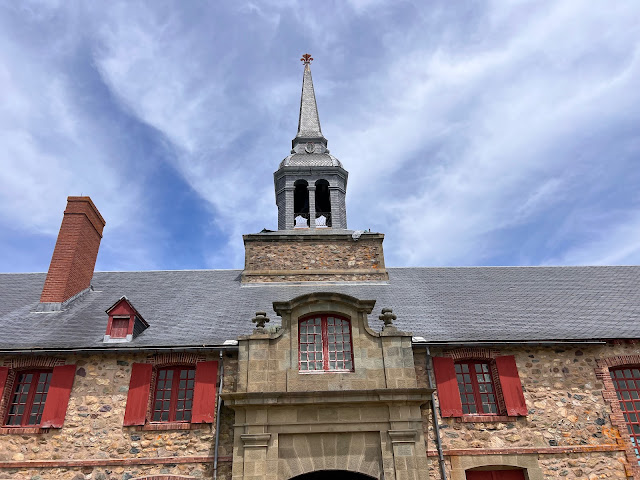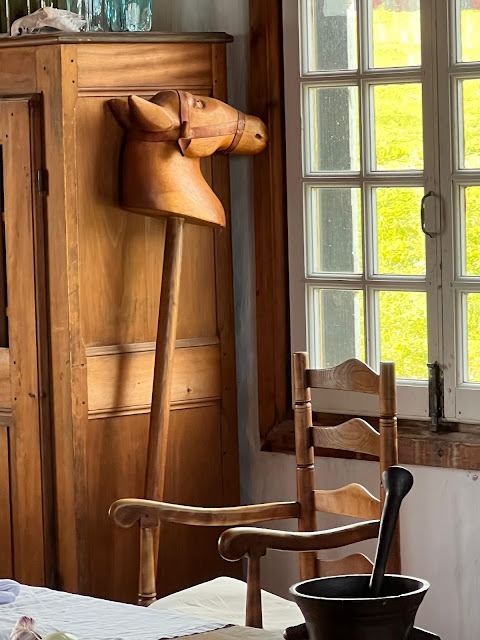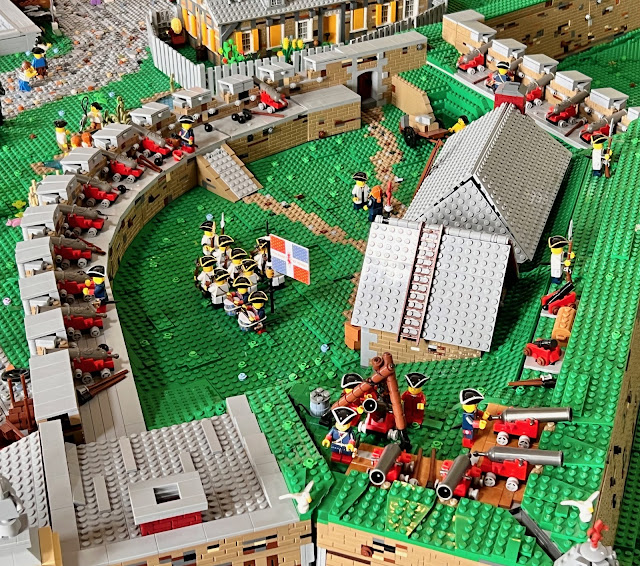US-Canada 2024-10: Nova Scotia—Louisbourg, Louisbrick, & the Big Fiddle
June 21-23, 2024
Town of Louisbourg on Louisbourg Harbor.
In fact, Doug requested we return for more huevos rancheros at Bistro Phare 756 in Louisbourg. A bit of serendipity awaited us on our return. Pulling up to the curb, we admired a Ducati motorcycle parked in front. After we ordered, Doug struck up a conversation with the gentleman at the neighboring table. Ryan, aka "Shrek," had ridden the Ducati from home in Bakersfield, California, just down the road from Visalia, our home (when we're there). Turned out he's friends with one of Doug's nephews and his uncle owns a popular Tex-Mex restaurant. He'd also just been to Quebec City, so we departed with lots of information.California meetup: Ryan rode his Ducati from Bakersfield. We drove our van from Visalia.
Lobster boats, Louisbourg Harbor.
We'd visited Fort Anne in Annapolis Royale, on the west side of Nova Scotia. From its beginnings in the 17th century, the fort changed hands between Scots, Acadians (French), and British, ending up with Britain by the 1713 Treaty of Utrecht.
Under that treaty, France lost both Acadia (Nova Scotia) and Newfoundland. Of its Atlantic possessions, it retained only Ile Royale (Cape Breton Island, not yet part of Nova Scotia) and Ile St-Jean (Prince Edward Island). Without Fort Anne, France needed a new fort to protect Quebec City and its fishing grounds.
Fortress of Louisbourg from across Louisbourg Harbor.
France decided to build the new fort on the east coast of Cape Breton on a C-shaped harbor with a narrow opening near the entrance to the Gulf of St Lawrence.
Construction of the fort began in 1719. The surrounding 36-foot-wide walls rose 30 feet above an 80-foot-wide ditch. Bounded by the harbor, the Atlantic Ocean, marshland, as well as Battery Island and Goat Island Battery just outside the harbor, it was believed the fort would be impregnable.
Ditch, walls, King's Bastion, from marshland.
Plus the sloping beach of North Cape was perfect for a careening wharf, where ships could be turned on their sides for maintenance and repairs.
A lighthouse was added to North Cape in 1734.
Louisbourg Harbor, North Cape: 1923 lighthouse under repair. Foundations of original 1734 lighthouse are nearby.
Louisbourg's walls included 148 embrasures (cannon emplacements).
Despite France thinking Louisbourg would be impervious to attack, soon after the fort's completion in 1745, New Englanders captured it, attacking by sea and by marshland.
Dauphin Gate & Demi-Bastion, on Louisbourg Harbor, bottom right. King's Bastion top right.
Sadly for the Americans, the Treaty of Aix-la-Chapelle returned Louisbourg to France.
King's Bastion. Dauphin Gate & Demi-Bastion, middle left.
Fleur de Lis tops King's Bastion, as it does all property of the King.
Quai & Frédéric Gate on Louisbourg Harbor.
Following its return to Frane, Louisbourg thrived for the next decade as an important center of commerce. The harbor and quai were busy places. Cod from the fishing grounds—for which there was stiff competition, cod being a major source of protein in Europe—was salted, dried, and left through Frédéric Gate to be shipped to Europe. Likewise, commercial goods from other countries arrived through Frédéric Gate.
Frédéric Gate, the door to commerce. Also where petty thieves were attached to the carcan by an iron collar for public shaming.
Louisbourg's peace and prosperity ended in 1758, when the British attacked—again by sea and land. Britain's 1757 attack had failed, but this time Louisbourg was taken. The British used it as a base to attack and take Montreal in 1759 and Quebec City in 1760. Then they demolished Louisbourg.
For 200 years, all that remained of Fortress Louisbourg were foundations.
Fortress Louisbourg remained a memory until Canada declared it a National Historic Site in 1920. In 1961, with the economy slumping and coal mining declining, Canada began to pump $25 million dollars into archaeological excavation and reconstruction of a quarter of the original fort.
We approached Fortress Louisbourg by land.
Looking down Louisbourg's main street, rue Toulouse. (l): Fence of deGannes house, Rodrigue House, Engineer's Residence, King's Storehouse. (r): de la Vallière House, Carrerot Property, Benoist Property, l'Epee Royale Café, Hôtel de la Marine.
Buildings were reconstructed on their original sites and as close as possible in the original style. Interiors include both original excavated artifacts and reproductions.
Hobby horse of one of the 6 de Gannes children. Families had as many as 12 children. Servants & sometimes slaves also lived with them.
Staff in period dress and in character, talk about history and customs and are happy to answer questions. All staff are employed year-round by Parks Canada.
Rue Royale, side street off rue Toulouse. (l): Rodrigue house & storehouse. (r): Engineer's Property, home to military engineers, who were town planners, construction engineers, architects, & military advisers.
A maid in the Engineer's House explains the workings of the pulley system for exchanging pots on the hearth, which she is very pleased to have.
Pulley system for exchanging pots.
Harpsichord entertainment, Engineer's House.
Louisbourg's gardens are maintained using 18th-century tools and techniques: compost for fertilizer; vinegar for weed control; companion plantings (e.g.. chive borders), hand pulling, soap and water for pest control.
Gardener at Engineer's Property Formal Gardens, designed in symmetric style of Versailles.
Walkways surround mounds. Rain water collects in the center. Chive borders for pest control.
Potager (kitchen) garden being readied for planting.
Rue Royale: Home of Robert Duhaget, an officer. Behind the fence is the ice house. Fleur de lis on top denotes it as property of the king.
We followed our noses along rue Royale to the King's Bakery, where bread is made and baked as it was in the 18th century. We arrive just as fresh bread for sale came out of the oven. Mmmm.
King's Bakery, a popular place, with delicious-smelling & tasting fresh-baked bread & rolls for sale.
Craftsmen working in the forge next to the bakery have perfected the use of 18th-century methods to design and fabricate replicas of 18th-century tools, equipment, and the like for the fortress. Along with tourism, worldwide sale of 18th-century artifact reproductions sustains Louisbourg.
(l-r) King's Storehouse. Home of Joseph Lartigue, magistrate. Lime Kiln. To right is Dauphin Gate; to left is Quai.
Quarried limestone was burned in the lime kiln, then mixed with sand to create a mortar. This mortar was used to form rubblestone into building blocks.
Buildings & lime kiln itself were built of rubblestone blocks.
Grandchamp Tavern & Hôtel de la Marine, corner of rue Toulouse & the Quai.
Continuing along the Quai, bottom to top: home of Nicolas Destouches, a baker. Commissaire-Ordonnateur's Property (on the corner). Property of Jean LaGrange, which included a sizable garden.
Joseph Dugas & Dominique Detcheverry duplex, rue Royale. Detcheverry, a blacksmith, hired Dugas, a carpenter, to build his home, with 1/2 of the building as payment.
Foundations of Jean-Chrysostome Loppinot home & Julien Fizel's Inn.
Plaque honoring Marie Marguerite Rose, among over 300 slaves in Louisbourg. When freed, she became a successful tavern keeper in the town.
The Great Tilly Hat Adventure, Part 1.
As he surveyed the harbor Doug's prized Tilly hat flew off, luckily landing on the beach, not in the water. Au secours! (Help!)
Doug & his Tilly hat, together again, along with bonus orange lobster buoy. The Tilly hat rescuer.
Lobster buoy. Marilyn was so happy for Doug!
And now, Sydney and the Big Fiddle!
Sydney Waterfront: The Big Fiddle, 60 feet tall, 8 tons, honors fiddlers & fiddle music in Cape Breton culture.
The Great Tilly Hat Adventure, Part 2.
Doug moved to the water, where his Tilly hat escaped again. His luck held: kids fishing from the pier fished out the hat. Phew!
Before we leave you, from 2017-24, a team of 5 adults who'd retained their childhood Lego passion designed, built, and constructed a 24-foot-long Lego model of Fortress Louisbourg. Fortress Louisbrick is a terrific exhibit for all ages. A discovery game sends kids running, er, walking very fast, to find the next building, ship, cow, or person on the list. Unfortunately, Fortress Louisbrick ends in October 2024, so go to Nova Scotia now—you won't regret it!
Fortress Louisbrick.
Dauphin Gate...
...& Demi-Bastion.
L: Louisbourg Harbor. Bottom: Forge & Storehouse, Lime Kiln, view down rue Royale.
King's Bastion & Barracks.
King's Bastion cannon emplacements, farm animals.
Houses & kitchen gardens.
And now, we do leave you, with this:
The Big Fiddle in action.
17 Days in Nova Scotia. Purple: Yarmouth-Peggy's Cove. Green: Halifax & Grand Desert. Eastern Shore to Cape Breton Island. Baddeck to Meat Cove. Red: Cabot Trail & Bras d'Or Lake. Louisbourg, Louisbrick, & the Big Fiddle. Blue: Last day in Nova Scotia.
.jpeg)






.jpeg)



.jpeg)

.jpeg)


.jpeg)








.jpeg)







.jpeg)

.jpeg)
.jpeg)



.jpeg)









.jpeg)
So much history! and fun!!
ReplyDeleteFascinating batch of history, especially military, and music and Legos! Keep on keepin' on, you guys.
ReplyDelete